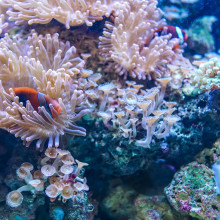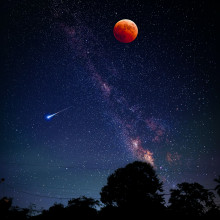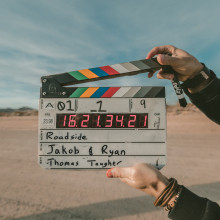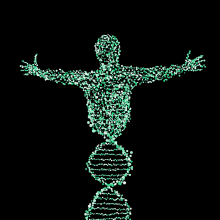Science of the Silver Screen
SPOILER ALERT: May contain poorly formed bias opinions on this past year's blockbusters. Now though, it's time to dress up to the nines and hit the red carpet in scientific style as we bring you The Naked Scientists Science of the Silver Screen Awards. Tonight we'll hear about the sandy planet in the sci-fi Dune, the likelihood of improvising a musical as portrayed by Disney's Encanto, Don't Look Up's planet destroying comet and the mysterious bioweapon that finished off Daniel Craig's James Bond. We did tell you there would be spoilers! In the news, the muscle types responsible for your dog's friendly face, warm water resistant corals and the reason why your friends are so much better at navigating their way through new environments. Now, it's time to put the lippy on and feel glamorous, settle in for a night like no other with The Naked Scientists...
In this episode

01:24 - COVID in China on the rise
COVID in China on the rise
Siân Griffiths
A massive omicron-fuelled outbreak of Covid cases is sweeping across China. Alongside Hong Kong, Shanghai has seen a big upswing in cases leading to over 25 million people returning to lockdown and businesses closing. But unlike the UK, where there are hundreds of thousands of cases per week, China has seen just a few thousand in total. The difference is that China continues to pursue a zero covid policy. Speaking with public health specialist Sian Griffiths, who was also involved in the original SARS outbreak in Hong Kong, James Tytko began by asking why the Chinese and UK approaches to managing Covid are still world’s apart…
Siân - That's to do with the choices of governments as to what strategy they're choosing in the UK and in many other countries. We're adopting a 'live with COVID' approach, which will allow cases of COVID in the community and will rely on vaccination to control the disease. In China and in Hong Kong, it's a zero COVID approach. That essentially relies on identifying cases, isolating them, isolating contacts, and dropping the transmission of infection so that you don't have infection in the community. It's just two sides of a coin.
James - Do you think that this is a viable strategy for China moving forward?
Siân - If you look at Hong Kong, as an example, Hong Kong has a population of 7 million people and has currently got an outbreak of Omicron. They didn't concentrate on vaccination, they concentrated on the 'zero COVID' approach of limiting the numbers of people coming into the country and controlling the numbers of disease. Unfortunately, once you have a very transmissible variant, such as the Omicron variant that's around at the current time, and an unvaccinated population, particularly the elderly, particularly those in care homes, you get a sudden surge in pressure on the health system and unfortunately in deaths.
James - Am I right in saying that recently Hong Kong, although they've been following China's lead for much of the pandemic in trying to stick to a zero COVID policy, haven't they recently started to reflect on their approach a bit more and ease some restrictions?
Siân - Hong Kong is changing its approach to COVID. Although officially it's still sticking with a dynamic zero COVID policy. That's what Carrie Lam, the chief executive said only yesterday. At the same time, they are starting to allow more flights in, because the economic impact on trade and by not allowing people into the country, by putting people who do go in even returning Hong Kongers who would have to go into quarantine at one stage for three weeks, that was just having such a harmful effect on the economy. If we look across to Shanghai, they had tried to be more liberal in the way that they were going to restrict and contain the population and then put in mass testing. However the costs are said to be in the billions for this exercise that they're going through at the current time.
James - And do you think that slightly more flexible, perhaps a more Western approach we're starting to see in Hong Kong might be a precursor for policy in China, perhaps?
Siân - It seems that it's a political decision and of course they do have some important political meetings coming up and reading around this subject, it would appear that the general feeling is that they'll stick with zero COVID until after those political meetings. Unfortunately, they are seeing more outbreaks across China, most of the major cities and living with COVID policy allows you to carry on with your normal business. The zero COVID policy means that you have to stop people going to work, stop the transport systems, you test everybody, and that's a hugely difficult and challenging thing to do and has an impact on the economy. They are thinking of loosening up, but I doubt that it's going to be an official change yet.
James - And I know you've talked about the economic impact. Was there any other knock on effects that might have for us here?
Siân - For us in the UK, it does impact cultural relationships. It impacts on social relationships. There are families who aren't able to get back together again. There are people leaving Hong Kong because they just can't tolerate the restrictions on their lifestyle because of the approach to COVID. Ultimately zero COVID is going to be almost impossible for China. We've seen the organism mutate, mutate, mutate, and every time we get a successful mutation, we get an increased number of cases. The difficulty for China will be whether the vaccines they're using, that are home grown vaccines, how effective are they as you get these continual mutations? It's going to be very hard to really cope with this. China does have high vaccination rates, although not at high in the over 80s, so there is a risk of that particular group who are more vulnerable to hospital admission being affected.

06:24 - Place of birth influences ability to navigate
Place of birth influences ability to navigate
Hugo Spiers, UCL
How confident do you feel navigating new terrain? Well, where you grew up - city vs countryside - could have a significant impact on your ability to do that, according to new research published this week. Julia Ravey spoke to Hugo Spiers from UCL about these results and took her own little unguided drive. But for the participants in the experiment, virtual navigation was how they went about it…
Hugo - In this video game, you play a little boat by tapping left or right to turn the boat around and you just sail out over different waters, looking for sea monsters to photograph them. It's generated data from more than 4 million people who downloaded it and played the game. When we have this large sample of people we can ask, you can actually start asking questions that might be quite difficult to get much of a result out of a small sample. This question of 'Did you grow up in a city or a rural environment?' turned out to be an important question. What we found here was that growing up in cities was worse for your navigation skill than growing up in a rural setting.
Julia - Okay? I'm gonna try and navigate my way home from work via King's College, which is in Cambridge, one of the most iconic buildings. But I'm not using the map to actually get there. I've only lived in Cambridge for like almost 6 months. I still don't really know my way around. I have to go out of here, turn right at the roundabout, go straight on, Girton College, a beefeater travellers rest on the right, keep going straight, bed and breakfast, right turn onto Mount pleasant...
Hugo - The next key result in our discovery was that you could predict the negative impact of the cities on a population. We are able to do that using this metric, which is known as the 'street network entropy measure'. Entropy is a mathematical measure to think about how disorganised a system is. A system with low entropy is highly organised. The grid layout in Manhattan has a very low entropy, but São Paulo has an extremely high entropy. The griddiness of the cities of a country made a difference.
Julia - Okay. So I'm now on a long road. That looks like a college to me. Girton College, landmark 1. We hit it.
Hugo - If you live in a city now, that's not the important question. It's ‘did you grow up in one?’ It's particularly griddy cities that seem to affect people's navigation.
Julia - Ooh. I'm way down the road now. I missed the beefeater. I missed the bed and breakfast. But I can see something called Mount Pleasant Hall. I did have to turn onto a road called Mount Pleasant. Oh, I've completely forgotten what I'm meant to do here? That says 'no entry'. Oh no. Okay? Big field. I feel like I had to go around a big field. Oh no.
Hugo - Across most of our lifespan, on average there's about a 5 year advantage. 50 or a 5 year old woman who grew up in a rural setting she's doing as well as a 60 year old woman who grew up in a city. What are the implications of this work is that future cities being built, they may need to think about having some grid and some non-grid and exposing people to the different patterns of city layouts. One possibility is that the brain circuits that process space for us and allow us to keep oriented and know where we are, are adapting. They're changing how they operate. They're expecting information about turns that are 90 degrees in a grid-like environment. But if you go into an environment where that expectation's not met, those neurons may not operate as optimally as they used to because they're used to working with information that has certain expectations built in. They make errors and those errors then lead to navigational, poor decision making.
Julia - I'm gonna go left here. Oh, it says buses and taxis only. And there's cameras. I'm definitely not risking that. But I can see King’s College from here. I can see it across the field. I think that's probably good enough. Right? Well done to me because I did get to the college. I just can't physically get to it.

11:28 - Heat resistant coral
Heat resistant coral
Kate Quigley, Minderoo Foundation
A way to spot corals resistant to the phenomenon of coral bleaching - which is threatening reefs around the world - has been published by researchers in Australia. The aim is to find corals from among the existing population that are naturally better able to tolerate the higher water temperatures that are driving the problem, and use those to understand the basis of that tolerance and possibly seed threatened reefs with those more robust varieties. But first you’ve got to find them, and that’s what the Minderoo Foundation’s Kate Quigley has been able to do by combining good old fashioned expeditions to The Great Barrier Reef with some machine learning techniques…
Kate - Reefs around the world and in particular, The Great Barrier Reef have suffered quite a lot of bleaching and mortalities due to global climate change and specifically warming due to global climate change.
Chris - And when coral bleaches in that way, what's actually happening?
Kate - It's a disruption in a relationship. Even though a coral looks like a slimy rock, it's actually an anima. Inside of that coral lives little algae, which are very similar to little plants. These algae provide most of the coral's food. They use the sun to go through some chemical processes and then they give that sugar to the coral. The problem arises when water temperatures become too hot and they stay hot for long. This disrupts that relationship, causing the coral itself to go white and if those conditions persist, the coral animal can eventually die.
Chris - But not all corals are equivalently vulnerable. Is that what you are postulating? If you're saying 'I'm going hunting for corals that are more resistant to that', then it's not a level playing field.
Kate - Some corals are intrinsically more tough and can survive increased temperatures. Other corals just seem to be less tough. We're really looking for these tough corals.
Chris - And is it the corals that are tough, or is it the algae that are tough, or is it both?
Kate - It's both. The coral animal is quite complex and some of this tolerance comes from the underlying DNA of the coral animal, and some of the toughness comes from the symbiote and together they create the response that we see on the reef.
Chris - So how did you actually go hunting then in this Italy sized hay sack?
Kate - Some of the first locations were just 'let's look for hot water'. I looked at hours upon hours upon hours of satellite data stretching over many years and had some best case scenarios in terms of where we could potentially find these heat tolerant corals. Once I had these particular areas, we went on an expedition and we collected corals that were essentially reproductively ready. We wait for a few days after the full moon, till the corals are ready to spawn. Once they spawn, we collect eggs and sperm and we mix them in specific combinations to create new combinations of coral babies. We put those coral babies through a series of different temperature experiments, where we can say, 'okay, these coral babies survive better under high heat stress, and then they survive less well.'
Chris - And what about the algae? The symbiotes that are part of the equation as well. How do they get added?
Kate - We gave them specific cocktails of symbiotes that we were hoping would further increase their heat tolerance. That means at the end of all of our experiments, we could essentially identify which genetic combinations of corals were really tough and which algae combinations were really tough.
Chris - When you do that, what sort of enhanced tolerance can you endow these corals with?
Kate - By doing this form of selective breeding, we were able to increase heat tolerance by 3 degrees Celsius.
Chris - Is that enough?
Kate - 3 degrees is a good start, but given the rate of warming, as well as the magnitude of warming that we're projected to see as soon as 2050, we're first going to need very strong action on climate change, even though these results are very promising.
Chris - Is there any way to spot places where there might be even more resistant corals and even more resistant algae that could be brought together in the way you have and get an even higher temperature tolerance?
Kate - Yes. This was the second part of our paper. We employed machine learning. You can just stick all this data into an algorithm and what it allowed for us to find was places around The Great Barrier Reef that fit the conditions that we had seen in our models. It told us that we needed to go to reefs that had high yearly temperatures. We also needed to reefs that had experienced a particular level of heat stress in previous years, so we could get a value around that. We also needed to go to places that had lots of variability, so in any one given day, the temperature fluctuation was quite high. With those 3 ingredients combined that was essentially the perfect cauldron for producing heat tolerant corals. We were able to find locations on The Great Barrier Reef that had this particular cocktail of scenarios and that allowed us to find that about 7.5% of the reef area on The Great Barrier Reef had these kinds of refugia.

17:16 - The evolution of dog adorability
The evolution of dog adorability
Annie Burrows, Duquesne University
Are you one of those people who can’t resist your dog when they cuddle up and look you right in the eye? A new study identifies key anatomical features that may explain what makes those doe-eyed expressions so adorable! Harry Lewis spoke with Annie Burrows, who was in the room with her colleagues Maddy and Jade, at Duquesne University to find out more…
Harry - To you 3, if you were to look at the face of a dog, what's the cutest part?
Jade - For some reason, I've always liked dog noses. I just think they're so cute and moist, especially like when they're sniffing you.
Maddy - I think the easy answer for me is when they give you the raised eyebrow look. But I also am a sucker for when they give you a big open mouth grin.
Annie - I guess I'm a little bit of an oddball here because I love dog ears. I love when they perk them up and lay them down when they're happy. I just think it's irresistible.
Harry - I'm looking at a picture of Alfie, which is my brother's dog. Alfie's a golden Cockerpoo. He looks a bit like a useless lion. He's got these really exaggerated facial features, particularly his eyebrows; they really make his eyes stand out and my whole family is in agreement that Alfie has the cutest eyes. It's funny because we've spoken to Annie and her research team before about research they did looking at puppy dog eyes. Annie should be kind enough to give us a refresher.
Annie - That research was an extension of some behavioural research that I worked on with a team that's primarily located in the UK. Where they went into various dog shelters in the UK and filmed dogs when people were watching them. What they found was that dogs that made that 'puppy-dog-eye face', were more quickly adopted than dogs who didn't make it. We did some facial dissections to just see what we could find underpinning that movement, and we found that almost all of the domestic dogs that we sampled had the levator muscle that makes that puppy-dog-eye face, whereas none of the wolves had it. It seems that somehow, through dog domestication, people were subconsciously or consciously selecting for that particular facial expression.
Harry - And your work hasn't stopped there. Between the three of you, you found out that these differences in muscle groups are actually represented in the whole face of dogs these days.
Annie - All mammals that we know of have mimetic muscles that are dominated by fast twitch fibres. That's why you get tired holding a smile for your auntie, who is asking you to keep smiling for the photos. That's because our face muscles contract quickly, but they get tired fast. What we found was that both humans and wolves have a large minority of slow twitch fibres in these face muscles. Dogs however, have a very tiny minority of slow twitch muscles. If we think about what do wolves and humans do with their faces that dogs don't, wolves howl. That's their primary mechanism of communication. In order to howl, if you try to make that face yourself, you have to purse your lips and hold that contraction. That requires some slow twitch muscle fibres. Humans use speech and as part of speech, we move our lips in very specific controlled fashions that also require slow twitch muscle fibres. But dogs bark and it doesn't really require much slow twitch movement.
Harry - Annie says, what this is indicative of is that really strong bond that we have with humans' best friend.
Annie - We shouldn't be surprised that we've selected dogs, whether consciously or subconsciously, that do things that we appreciate. Wolves don't bark, but dogs do bark. That's one of the key things that people look for in a dog is protection. But also it points to the huge emphasis that humans dogs place on mutual gaze. This ability to attract one another's attention with facial expression and deepen that bond.

25:34 - How to build a sci-fi planet from scratch
How to build a sci-fi planet from scratch
Andy Howell, Las Cumbres Observatory
Dune is a sci-fi masterclass where the inhabitants are able to use their technology to breathe and fight it out on the sandy planet that would otherwise remain desolate. Otis Kingsman reports…
Otis - Most of the technology in the film is based around this fictional theory called the Holtzman effect. This in-universe discovery is described as relating to the repellant force of subatomic particles. Here with us to explain this a bit further is Andy Howell from the hit YouTube series Science vs Cinema. What exactly is this repellant force of subatomic particles?
Andy - It's a fictional construct to be able to justify all the fanciful cool technology they have in Dune, but there are parallels in real world physics. It's hard to put two charged particles together that have the same charge, but we can do it in the atomic nucleus because of the strong force. That's what allows protons to all really be stuck together in atoms. It's sort of efficient storytelling where you just say, ‘well, there was this real genius out there that figured out a bunch of cool stuff.”
Otis - Holtzman shields in the film are integrated into the armor of the soldiers and were designed to prevent fast moving objects like bullets and lasers from penetrating it. However it does allow slow moving objects like knives and more importantly, air to pass through unharmed. Andy, is this something we can replicate using our own current technology?
Andy - There's not a one to one parallel, but this is a clever way to justify having futuristic technology, but still having swords and not having bullets. But there are some things that are similar. There's a substance called oobleck and that's just basically mixing cornstarch and water. If you smack it hard, it becomes a solid, but if you touch it easily your fingers go right through. It's a liquid. I once filmed a TV show for national geographic where we mixed up a big vat of this stuff, and I got to effectively walk on water. As long as I was running, I could stay on the surface because it was a solid, but if I stopped I would sink down.
Otis - The shield is often displayed as a blue distortion, but this goo you're talking about is, if anything, probably closer to the 1984 Dune film adaptation where it's just blocks of see through jelly-like substances surrounding their bodies.
Andy - Sometimes we have shields on say a space station. Now, that's a physical shield layers of material that are offset from each other so that if a particle comes through really fast, almost like a bullet, but there's, you know, space debris out there, it'll get hit by the shield and break up. But you could have similar kinds of shielding for charged particles using just magnetic fields because charged particles bend in a magnetic field and spin around. So in some cases you want to shield electromagnetically and in some cases you want to do it physically. Of course, we have things like body armour as well, that can take away the kinetic energy of a fast moving projectile and spread that out over a bigger area.
Otis - Dune is supposedly set 20,000 years in our future. In your opinion, how believable and how scientifically accurate is the science of Dune on a scale of 1 to 10?
Andy - I don't know. 7 for believability. But I don't think you could condense it to one number because the goal of science fiction is not really to be accurate, it's to tell a really good story. I believe that in telling a really good story, what you need to do is make something that seems generally plausible and fits within the boundaries you've set of that universe. That's exactly what Dune has done here. They've taken some plausible sounding things and have some technology that makes the story really cool, but they give you a way to write it off. I think that's ideal storytelling.

30:41 - Is there any science to Disney?
Is there any science to Disney?
Alisun Pawley, University of York
Encanto is a film in which each member of a Colombian family is gifted with magical powers when they become of age. I hear you, science in a Disney film? Impossible! Or is it? Here’s musicologist Alisun Pawley from the University of York…
Alisun - I think it's all in how the musical is crafted. Encanto does it so beautifully that as an audience member, I'm willing to go into that imaginative world because you are drawn into those characters so well. You know, there's that sort of well known version of Les Misérables where it's sung throughout the whole thing. Having all the dialogue and on the screen for me, it doesn't work as well. I can't go quite that far. On the stage I think it works a lot better, but on the screen, there's just a little bit too much of my logical brain interfering.
Julia - One of the most noticeable things about the music in Encanto, I guess this applies to most animated films, is the fact that they appear to be singing off the cuff, but at the same time, they're all harmonizing. That would be impossible in real life, right?
Alisun - Okay. So harmony in group singing can vary in the form it takes, and also it can vary between cultures. In some societies it's quite normal to sing in group harmony. In this country if you sort of burst into a song in a supermarket I'm not sure people would start joining in with harmonies, but it might not be out of place in somewhere like South Africa, for example.
Julia - Okay. How does that apply to Encanto?
Alisun - In 'We Don't Talk About Bruno' the characters are all singing their own melodies that you could imagine maybe they improvised. They're all singing them layered on top of each other. It is actually somewhat realistic that they could do that. The chord sequence underneath is sort of the same for each of the characters' melodies, so it means that they can layer them all on top of each other and it works beautifully. It's something Lin Manuel Miranda does in a lot of his music, this sort of layering approach and it's very powerful and exciting when it happens.
Julia - Right. You said the big hit there 'We Don't Talk About Bruno', it's mine and Harry's favorite ear worm at the minute, is fairly believable. Is that partly due to where the film is set?
Alisun - Yes. So, Columbia has very rich musical traditions. It's known as ‘the land of a thousand rhythms’. One of the most popular is called Vallenato; it's a tradition of vocal improvisation. They have sort of battles between two singers. The tradition of improvising vocally is quite strong within that culture, and I think the opening number, 'The Family Madrigal' sung by Mirabel, that opening scene is very believable within Columbian culture I would say.
Julia - Go on then on a scale of 1 to 10, how likely is it that Encanto is scientifically accurate? How likely is it that if people in Colombia burst into song, they would recreate something similar to the music we see in this movie?
Alisun - Ooh, that's hard. I'll be generous. Give it a 6.
Julia - That's very generous. You get me up on a table any day of the week, but I'm sure most people are going to stand and stare at a flash mob rather than joining in. Maybe Columbia is just made up of oddities like me. Why 6 out of 10?
Alisun - The opening number, like I was saying, if you had a very talented improviser, that's quite believable. 'We Don't Talk About Bruno' is sort of in between because everyone's improvising their bits to that hook that everyone can sing. You can quite plausibly learn. There's a moment in that song where you have to suspend your disbelief when they sing. “Your fate is sealed when your prophecy is read.” It’s very unlikely that a group of townspeople will have rehearsed that line and come together and sung it in that moment.

35:41 - Is the science far out in space movies?
Is the science far out in space movies?
Amy Mainzer, NASA
Don’t Look Up is an apocalyptic black comedy where humanity finds itself in the headlights of a planet destroying comet. NASA astronomer Amy Mainzer worked as the science advisor for the film and spoke to Otis Kingsman…
Amy - The director originally wanted the object to be a much larger asteroid, something in the range of about 60 kilometers across and he wanted it to be an asteroid. So we had to come to a compromise on that. I had suggested that instead of an asteroid of that size, which is so big that it really would be absolutely hopeless to try to stop such an object, that we really wanted something that was smaller. Still plenty large enough to cause a lot of damage, but small enough that we would have a reasonable chance of doing something about it. Basically anything that's in that size range, something larger than say about a kilometer across is big enough to cause what we would call global damage. And then also switching from an asteroid to a comet, there were a couple of reasons for this one we have really, at this point now mapped out most of where asteroids that get close to the earth in that size range are. The really truly big ones we know where most of these are now. But comets on the other hand come from much further away. This particular class long period comments can come from out of the blue. We sometimes find them with only a few months of notice; Just like comet Neowise, which we discovered in 2020. That object we found within a few months of its closest approach to the earth and the sun. So, that's quite realistic.
Otis - I suppose the temptation is to think that bigger is better, but as you've just explained, that's not always the case.
Amy - That's one of the important things I think about interacting with a movie crew as a scientist, you want to bring enough scientific realism to the production that it doesn't pop you out of the story. In this case, of course, the comet in this movie is really an allegory for a lot of different kinds of global problems that we face as a society like climate change, loss of biodiversity and even the pandemic. But you know, in this case, we wanted to make the point that if everybody works together as a society, we actually can do something about these big global problems. It's not hopeless.
Otis - Yeah. I didn't really question any of the science when watching it; I was too hooked. Take, for example, when Jennifer Lawrence's character first discovered the comet, I assume the maths and the formula were accurate?
Amy - In this case, in the movie what you're seeing is a group of astronomers who actually don't study comets as their primary science objectives, they study something else. I think these are characters who in their day-to-day lives, wouldn't calculate asteroid or comet orbits. Leonardo DeCaprio, he's a professor, he's got a bunch of students with him. He's trying to teach them and use the discovery of the comet as a teachable moment and he's gotta go look up in a textbook how to actually do this kind of math. It's not something he would do every day. That's pretty realistic.
Otis - If we actually had one of these comets heading towards earth, would it be possible to redirect it as discussed in the movie?
Amy - The single most important thing that we need is time. If we don't have a lot of time, it's much harder. What you see in the movie is there's this huge worldwide scrambled to launch spacecraft equipped with explosives that can push the comet out of the way. That task is made considerably more complex in real life, because it's very hard for us to build a spacecraft in less than a year, realistically. Not only that, it's not just the time that it takes to build a spacecraft capable of deflecting the object, but the energy that you require for your task actually gets considerably easier if you have more time. In other words, it takes less energy to push it out of the way if you can find it years to decades in advance, instead of just 6 months in advance. If you can even do such a deflection mission at all within 6 months. Time is really the most important thing.
Otis - Sure. The closer to the earth the comet the bigger the deflection we would require. I mean, this all sounds rather well thought. In your unbiased opinion, how scientifically accurate is Don't Look Up?
Amy - I would say this movie is about an 8 out of 10. It's pretty good in terms of the presentation of the scientists in doing their best to discover the object and track it, figure out where it's going, and then let everybody know that there is a large and imminent danger out there to society and to the planet. That's very realistic.

40:59 - Is No Time to Die's bioweapon plausible?
Is No Time to Die's bioweapon plausible?
Cassidy Ward
The James Bond film, 'No Time to Die' centres around a bioweapon that can be tailored to an individual’s genetic makeup using nanomachines. It’s called ‘Project Heracles’. Harry Lewis interviews SYFY journalist and author, Cassidy Ward to look into if something like this would be realistic...
Cassidy - The short answer is no. We obviously do have bio weapons, they've been around for about as long as warfare has been a thing, but this sort of takes that to an extreme. We obviously also do have nanotech and we have gene editing capabilities. Heracles sort of imagines what we might be able to do if we had a perfect understanding of all of those fields and then put them to nefarious uses. Really, when it comes to bio weapons, this has absolutely been a concern for governments and for defence organizations for a while - since the genetic age started. It's not the most farfetched thing in the world. The reason perhaps that we don't have weapons like this is that they're really not necessary. We sadly have plenty of other ways to hurt one another.
Harry - You spoke about nanobots there, briefly. This is something that we actually use at the moment in day to day life is it?
Cassidy - Not so much in our day to day lives. The robots that we're likely to see in the day to day are much larger and don't have the sort of capabilities that we imagine in our future. The robots you're likely to encounter in the day to day are good at vacuuming your house or moving parts on a factory floor. In terms of medicine, nanobot tech is certainly improving. There was a recent paper published in the journal Science, for instance, where they used injectable nanofibers to promote and enhance healing in spinal injuries. That study was done in mice, but it was very promising. So that potential for nanobots and medicine is certainly there.
Harry - There's something that we see quite a lot of in the news: it's the idea of personalised medicine. In this, it's the use of how we tailor treatments and it's something that really becoming big at the moment to one's genetic disposition. This film sort of feels like it builds on that, but just following it down a different avenue, right?
Cassidy - Yeah, absolutely. Gene therapy is an emerging field of medicine, particularly for treating cancers and genetic diseases. The process involves identifying a target gene and then modifying it in some way. Depending on the specific circumstances, that might mean replacing a gene with a clean copy or turning it off altogether, or adding a new gene. Technologies like CRISPR have absolutely improved our ability to do that sort of work. Gene editing also allows us to create new therapies which have a wider audience than just one person. There was, for instance, a recent study involving spider silk proteins to modify a human protein called P53, which can put cancer cells into a sort of self destruct mode. So, yeah, 'No Time to Die', takes these capabilities and flips them on their head to ask the question, "What if we use genetic technologies for violence instead of for therapies?"
Harry - Cassidy, in something like James Bond, when we start to compare something that's real world, like with personalised medicine, and then you have something which speaks about personalised weaponry, is there a chance that this is harmful for people? We get a lot of science from our entertainment, right? And so, if we are crossing these wires, does that make it at all dangerous?
Cassidy - Science fiction in particular has the ability to imagine new futures. A lot of the time those prophecies become self-fulfilling. There's plenty of examples of not just technologies like space travel that were first dreamed up in science fiction before they were made realities, but scientists who get inspired from stories to get into the field. Really, we can only create a future if we can first imagine it and we probably should be careful about the sorts of futures that we imagine.
Harry - Yeah. It's a really interesting thought. In 'No Time to Die', he gets infected by the bio weapon and he is told by the supreme arch nemesis that it isn't reversible. If we were to be infected by a bio weapon, is there a chance that it wouldn't be reversible?
Cassidy - This was honestly my biggest gripe with the movie first off. I think if the villain is telling you something, it's probably worthwhile to not take that at face value. But I think that this is where a lot of science and fiction falls apart. When there's a choice between accuracy and drama stories often lead toward drama. We're not given a lot of specifics about exactly how Heracles works, but I think it's reasonable to assume that something could have been done; that the bots weren't infecting Bond directly, they were sort of holding up in his body, waiting for their intended target. I also think it's likely that the bots would've degraded in his body over time, and Bond also had access to some of the most advanced technology and brilliant minds in the world. If anyone could have fixed it, it's probably Q. I think Bond was just being a little dramatic.
Harry - And just finally, if you had to give it a score, how scientifically accurate, albeit hypothetically, is project Heracles and James Bond's 'No Time to Die.'
Cassidy - If I were to put project Heracles in today's world, I'd have to give a five or a six. It's built on a foundation of real science, but it asks the audience to take some pretty big leaps of faith in the way that it works. If we push the timeline forward a little bit, that score very likely would go up. I don't think it's impossible, but I do think it's unlikely, which is great because this is probably one of those cases where we don't want life to imitate art.

46:09 - The life of a Hollywood scientific advisor
The life of a Hollywood scientific advisor
Erin Macdonald
When it comes to adding scientific content to a new blockbuster, the director has a conudrum on their hands. Make it too believable, and the audience might be bored out of their minds, make it too whacky and the audience will hit the stop button and find something else to watch. Otis Kingsman took a look at this year's Naked Scientists Science of the Silver Screen Awards shortlisted nominees and spoke with a real life Hollywood scientific advisor, Erin MacDonald, to see how one goes about making a film that everyone can enjoy!
Otis - There go the credits. I just finished rewatching our nominated films. I think, before we get on with the prize giving, I'd better find someone who can help us run a critical eye through our selection. One show that has definitely got scientists and science fiction enthusiasts hooked for over 50 years is Star Trek. They've done something right there. And fortunate enough, I have Erin MacDonald on hand, one of the scientific advisors to Star Trek itself. I started off by asking her, "At what stage of movie making is it that a real scientist gets pulled in to help."
Erin - Sometimes I'll have discussions with writers when they have an idea for a film and they just want to bounce some ideas around with like, "Maybe how the engines can work", or maybe, "How the space station could work." But sometimes I get brought in late in the day when they have a draft of a script and they're like, "We'd really like eyes on this as a scientist." It's like this improv philosophy of someone comes to me with some whacky story about time travel and music and sound and space and disastrous space aliens, and my job is not to say, "No that'll never work." My job is to say, "Okay, cool. Let's try to see how we can make that happen."
Otis - Erin tells me that the most important part of her job is ensuring that the audience remains engaged with the cinematic content. That means it can't necessarily be too whacky depending on the film. It might even need to adhere to general scientific principles. In short, there needs to be a set of rules that could mean a lot of work for a really small feature in the show.
Erin - Sometimes we'll build up tons of scientific backbone for the story and then that gets edited down to like one line of dialogue. You just want to make sure that, when they're doing that, it's not interrupting the actual flow and the cadence or anything else like that.
Otis - And sometimes after all of our efforts, it can be best not to mention any of the hard work at all.
Erin - You can look at an episode of Star Trek: Lower Decks, for example, that will have the strange energies that possess the second in command, and then he becomes a God-like creature. As soon as you try to explain it, then you start to lose the audience. A lot of times I say to writers, "Okay, that's really cool. Let's do it. Let's just not explain it."
Otis - Erin says that scientific inaccuracies which tend to throw people off are fairly easily avoided if you take the time to build up a portfolio of the likely audience and understand your genre.
Erin - A lot of it is just the basic knowledge that people have. One that comes to mind is sound and space: everyone knows the tagline, "In space, no one can hear you scream" from 'Alien'. So, anytime you have sound in space, that will pull people out. One where we do break it and it doesn't pull an audience out is the beginning of 'The Martian' The whole inciting incident of 'The Martian' with the big windstorm that's knocking the ship over and blows a satellite dish into Mark Watney, that would never actually happen on Mars because the atmosphere is way too thin to actually physically blow an object like that, but not a lot of people know that and so it doesn't pull them out of the film. Without that, there wouldn't be a story.
Otis - In fact, the audience itself has a huge influence on how much scientific language, fictional or not, is used, along with how scientifically accurate the film needs to be in general.
Erin - With 'Star Trek: Lower Decks', that's an adult comedy audience and so we're not worried much about science at all. My job in that aspect is just to make sure we don't say anything wrong. But then, for example, we also have a show called 'Star Trek: Prodigy', which is aimed at children. For that, it's not just getting the science right, but explaining it in a way that's almost educational.
Otis - It feels strange to think that there are Star Trek shows which go easy on the physics. Now, I'm not a Trekkie, but I do happen to know one. Chris Smith loves all of it. I spoke with him a little earlier to find out why he loves boldly going where no man has gone before.
Chris - One of my fondest memories as a child was being taken to see 'The Wrath of Kahn' at the cinema by my dad. It was actually one of the first times I'd ever been to the cinema which made it special, but I just loved that kind of movie. The thing that really makes Star Trek stand the test of time, in my mind, is that those technologies they had in the early days were things we all wanted, but never thought we would have. And now we have: we've got mobile phones, well those were their communicators, we've got iPads and tablets, they have those as well. They had that big screen GPS navigation system, that's in everyone's car these days, and then there are other things like MRI scans to produce those amazing detailed body scans, and the enterprise even had smart speakers. And here we are today talking to our Alexa and Google devices in the same way that people in 'The Next Generation' used touch their badge and ask the computer something, and we all rolled our eyes and thought, "Oh yeah, that'll never happen." And here we are. I think it's an amazing series. I will continue to love it to my dying day.
Otis - A true Star Trek fan is our Chris, summing up the scientific plausibilities we see on the TV. But before I hand it all over to Julia and Harry for the final verdict, I wanted to share some more of Erin's wisdom. I had her look over our four nominees and she was quick to point out that each one needs to be approached from a different perspective.
Erin - I love your selection of movies because it really speaks to your attitude here going in as a viewer. For example, when I went into 'Encanto', I was not there to scientifically analyse the plot, but it's really fun to use something like 'Encanto' to teach science or to introduce scientific topics that we haven't seen before. And when you're talking about James Bond and using nanobots, again, that's something that you go into wanting to watch an action film, and James Bond has that long legacy of weird, cool technical devices, so you're more willing to let those things go. When it comes to 'Don't Look Up', I might go in kind of curious about that asteroid, but I'm really watching it to try to see how people are going to react to an asteroid that's coming to kill the earth. And then, of course, I'm saving the best for last because 'Dune' you go in and you're like, "Oh, this is hard sci-fi. This is science fiction that's really detailed, really thought out. You go in kind of expecting to have your mind blown with new scientific phenomenon or ideas that you might not have had before, but it's really just such a cool way of having us see the potential in our universe.

55:49 - QotW: Identifying diseased genes
QotW: Identifying diseased genes
When infected with a new disease, it’s imperative for scientists to know exactly what it is in order to find the best cure for it. So how do they do it? Here to break it down to Otis Kingsman is Jocelynn Pearl from Tune Therapeutics of the Lady Scientist Podcast...
Jocelynn - When attempting to identify a disease, we have to compare two different sequences within the gene. If we think of the set of genes in someone’s chromosomes like a library of books, we can think of the hunt for a disease gene like looking for a book where an important word or sentence is different to the correct version - in this case, the transcription or translation of that gene.
Otis - Changes to the genetic sequence of a gene are called mutations. We can read these out using sequencing technology.
Jocelynn - The common way we sequence genes is by using Sanger Sequencing developed by Nobel Laureate Frederick Sanger and his colleagues in 1977. The sequence splits a gene into four base pairs of DNA, called nucleotides, represented as A, T, C, or G which stands for adenine, thymine, cytosine and guanine. Each group of 3 nucleotides is called a codon and these get translated to amino acids, the building blocks of proteins.
Otis - These proteins are the instructions for all sorts of processes within our bodies. When a disease is present, it leads to a mutation occurring in the codons in the protein.
Jocelynn - This disruption in the transcription or translation of the gene can change the function of the protein or the amount of that protein in a person. For example, in sickle cell disease, the gene that encodes the protein ‘beta hemoglobin’ is mutated. Where there should be an “A” nucleotide, there is a “T”, and this mutated gene makes a person's red blood cells form a sickle shape so they cannot carry enough oxygen around the body.
Otis - The human genome is complex. It is like sifting through multiple libraries. As such finding these mutations can still be quite difficult. Fortunately, we have a few tools and techniques to help us.
Jocelynn - We use tools like ‘whole genome sequencing’ to find things like inherited gene mutations. We also use something called ‘genetic markers’ to conduct ‘genome-wide association studies’. These make comparisons across populations of people to understand genes that are associated with more complex diseases that might be caused by multiple factors - things like obesity or schizophrenia. Over the years we have learned more about the genes that can cause disease, but there is still much to learn.
Otis - So Malcolm, scientists identify diseased genes by looking for mutations within the DNA sequences. If our colons aren’t correct, then it will affect the function of our proteins and lead to illnesses and problems within our body. But thanks to new technologies and developments in medicine, by identifying them we can start to figure out how to best cure it. Thank you to Jocelynn Pearl for clearing things up. Next week, we’ll be charging head first into this question from listener Barry.
Barry - “What causes degradation in electric car batteries? And what are the upcoming developments in EV battery technology?”










Comments
Add a comment